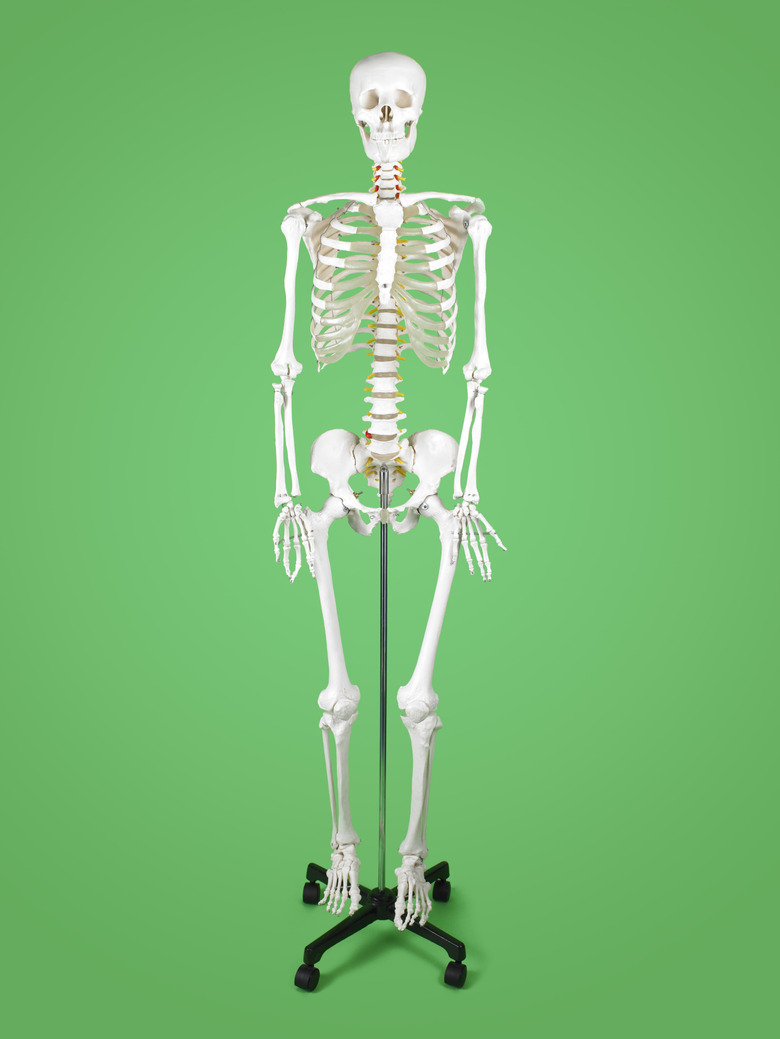Human Anatomy Projects
Human anatomy studies the structure of the human body. Hands-on projects that investigate the relationship between body structure and resulting function can help you learn how structures, such as your bones, muscles, brain cells and heart, interact to produce a functioning human. Whether you use a paper model, a fetal pig or your own body as your test subject, these projects will help you increase your understanding and retention of the material.
Bones and Joints
Bones and Joints
You can use a paper model of a human skeleton to study bones and joints, and can adapt it to particular bones or joints in the human body. Cut out a paper model of the human skeleton and use paper brads to attach the bones at the joints. Label the bones on the back of the skeleton. Identify the bones that are used primarily for protection, such as the cranium, sternum and ribs, and color them yellow. Identify the ball-in-socket joints and color them green, and choose two hinge joints and color them purple. Finally, identify and draw in one ligament, a fibrous band of tissue that connects two bones, and color it orange.
Left-Side or Right-Side Dominance
Left-Side or Right-Side Dominance
The left side of your brain controls muscles on your right side, while the right side of your brain controls muscles on your left side. Thus, the left side of your brain is more active when you write with your right hand. Although you probably know whether you or your friends are right- or left-handed, foot and ear dominance may not be as obvious. Record the foot each of your classmates uses to step up a stair, kick a ball and step on a coin placed on the floor. To test ear dominance, whisper a statement and ask your subjects to cup one ear to try to hear what you're saying. You can also ask them to try to listen through a wall or to a sound from a box by pressing one ear to the wall or box.
Heart Rate Before and After Exercise
Heart Rate Before and After Exercise
Your heart is a special muscle that pumps blood throughout your body to transport oxygen and other nutrients to your muscles and other tissues. When you exercise, your muscles require more oxygen than they do at rest, and this requires your heart to beat faster to supply more oxygen-containing blood to your muscles. To measure your heart rate at rest, place your index and middle finger on the underside of your wrist or the side of your throat. Count the number of beats you observe during a 15-second period. Multiply this by four to get the number of beats per minute. Next, do jumping jacks or run in place for one minute, and then measure your heart rate again.
Real or Virtual Fetal Pig Dissection
Real or Virtual Fetal Pig Dissection
Although a fetal pig may not be anatomically identical to a human, a real or online-based virtual fetal pig dissection is still valuable for investigating the mammalian bones, muscles and organ systems, and many of these systems are similar to those of a human. Comparing the structural differences between a fetal pig and a human also reveals how structure may influence function. For example, the locations of some of the chest muscles that attach to the shoulder girdle are different between pigs and humans due to the fact that pigs walk on four legs, while humans walk on two.
Cite This Article
MLA
Battaglia, Gina. "Human Anatomy Projects" sciencing.com, https://www.sciencing.com/human-anatomy-projects-12754324/. 19 September 2013.
APA
Battaglia, Gina. (2013, September 19). Human Anatomy Projects. sciencing.com. Retrieved from https://www.sciencing.com/human-anatomy-projects-12754324/
Chicago
Battaglia, Gina. Human Anatomy Projects last modified March 24, 2022. https://www.sciencing.com/human-anatomy-projects-12754324/
